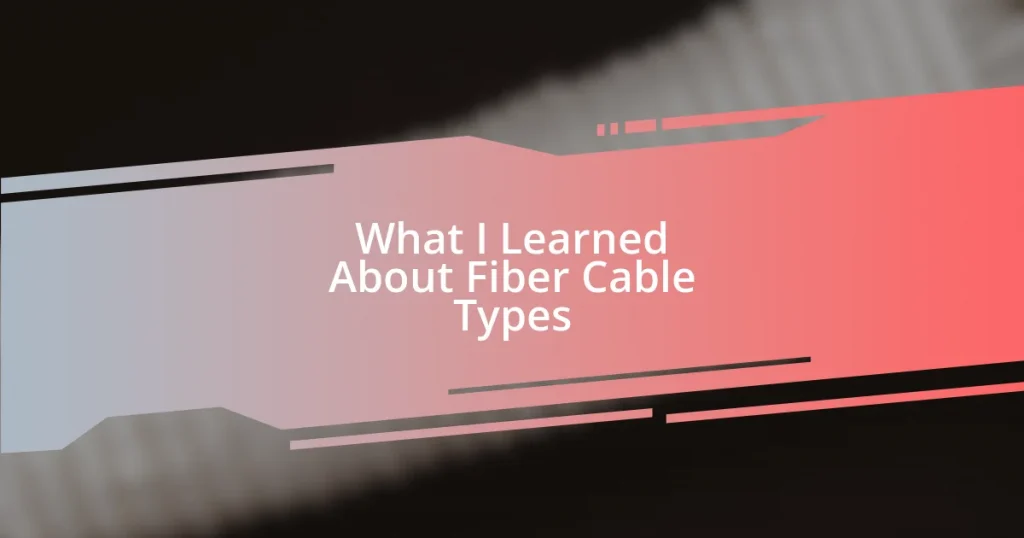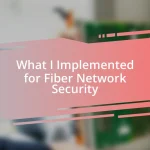Key takeaways:
- Fiber optics transmit data using light signals through thin strands, with single-mode fibers suited for long-distance communication and multi-mode fibers for shorter distances.
- Proper installation techniques and team collaboration are essential to avoid signal loss and ensure compliance with safety regulations during fiber optic installations.
- Future trends in fiber technology include the development of hollow-core fibers for reduced latency, AI integration for network management, and sustainable production practices for environmental responsibility.

Understanding Fiber Optic Basics
Fiber optic technology is truly fascinating. At its core, fiber optics involves sending data as light signals through thin strands of glass or plastic. I remember my first encounter with this technology; the way light danced within the cable seemed almost magical, sparking my curiosity about how such simple materials could transmit information so quickly.
The basic components of fiber optics are the core, cladding, and protective layer. The core carries the light, while the cladding reflects it back to keep the signal strong and efficient. Have you ever thought about how a simple twist of these materials can transmit high-speed internet for thousands of miles? It’s mind-blowing, really, that such a system can support our daily activities, from streaming our favorite shows to facilitating online meetings.
Understanding the difference between single-mode and multi-mode fibers opened my eyes to the versatility of fiber optics. Single-mode fiber, with its narrower core, is ideal for long-distance communication, while multi-mode fiber is suited for shorter distances, like within a building. Reflecting on my early projects, choosing the right type of fiber was a game-changer, showing me how important it is to match the technology with the specific needs at hand.
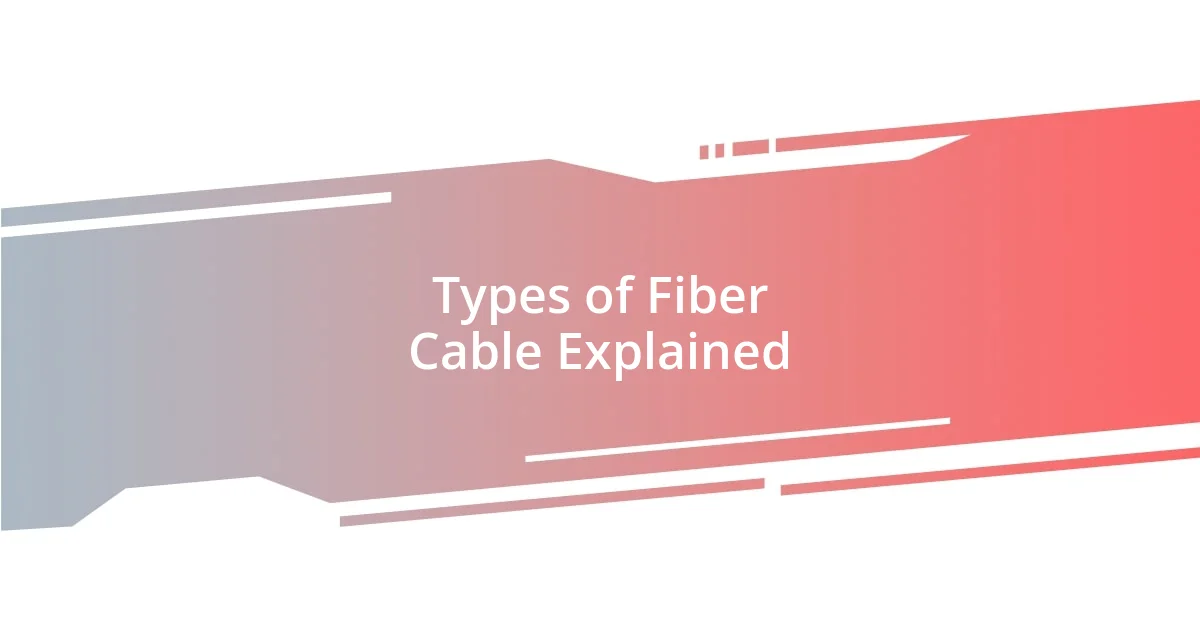
Types of Fiber Cable Explained
The world of fiber cables can be broken down into two main types: single-mode and multi-mode fibers. I remember when I was first tasked with selecting cables for a networking project; the choice between these two felt overwhelming. What’s crucial here is understanding their unique applications—single-mode fibers are perfect for long distances due to their ability to transmit light directly down the core, while multi-mode fibers, with their larger core, are better suited for shorter distances where higher bandwidth is required.
Here’s a quick overview of the two types:
-
Single-Mode Fiber:
- Has a small core (about 9 micrometers).
- Supports longer distances, often exceeding 40 kilometers.
- Provides higher bandwidth and lower signal attenuation.
-
Multi-Mode Fiber:
- Features a larger core (around 50 to 62.5 micrometers).
- Best for shorter distances, typically up to 300 meters.
- Allows multiple light paths, resulting in more modal dispersion.
Reflecting on my early experiences, I realized that picking the right type of fiber significantly impacted not just the performance of the network but also the overall efficiency of our communication systems. It’s a little like choosing the right tool for a specific job; using the wrong type can mean the difference between seamless connectivity and frustrating delays.
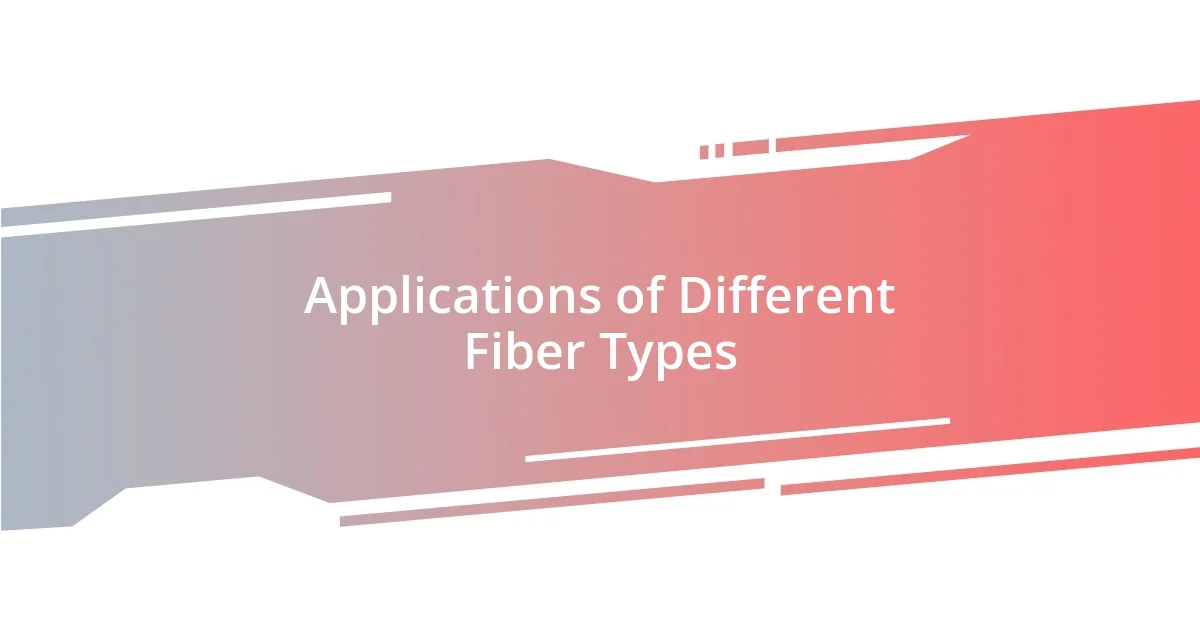
Applications of Different Fiber Types
The applications of different fiber types have a profound impact on how our networks are structured and function. For instance, I’ve worked on several telecommunication projects where single-mode fiber was the clear choice. Its ability to cover vast distances with minimal signal loss made it perfect for connecting cities and remote areas. It’s fascinating to think about how thousands of miles of these cables enable seamless global communication, which I’ve often taken for granted.
On a different note, multi-mode fiber has become indispensable in data centers and local area networks. I recall walking through a data center buzzing with energy, where I noticed multi-mode fibers linking racks of servers in every direction. The thicker core allowed for higher data throughput over shorter distances, making it vital for high-speed internal networking. This experience reinforced my understanding of how the right fiber type not only supports efficiency but also plays a crucial role in enhancing the overall performance of a network.
Understanding the specific applications of these fibers really shaped my perspectives on networking solutions. I remember leading a team to upgrade a university’s internal cabling system; choosing multi-mode fibers for their buildings meant faster connections for students and faculty alike. I saw firsthand how the choice of fiber directly impacted daily life, improving the experience of all who relied on those networks for research, learning, and communication.
| Fiber Type | Applications |
|---|---|
| Single-Mode Fiber | Long-distance telecommunications, undersea communication, and high-speed data transmission over great distances. |
| Multi-Mode Fiber | Local area networks, data centers, and short-distance communication between devices. |
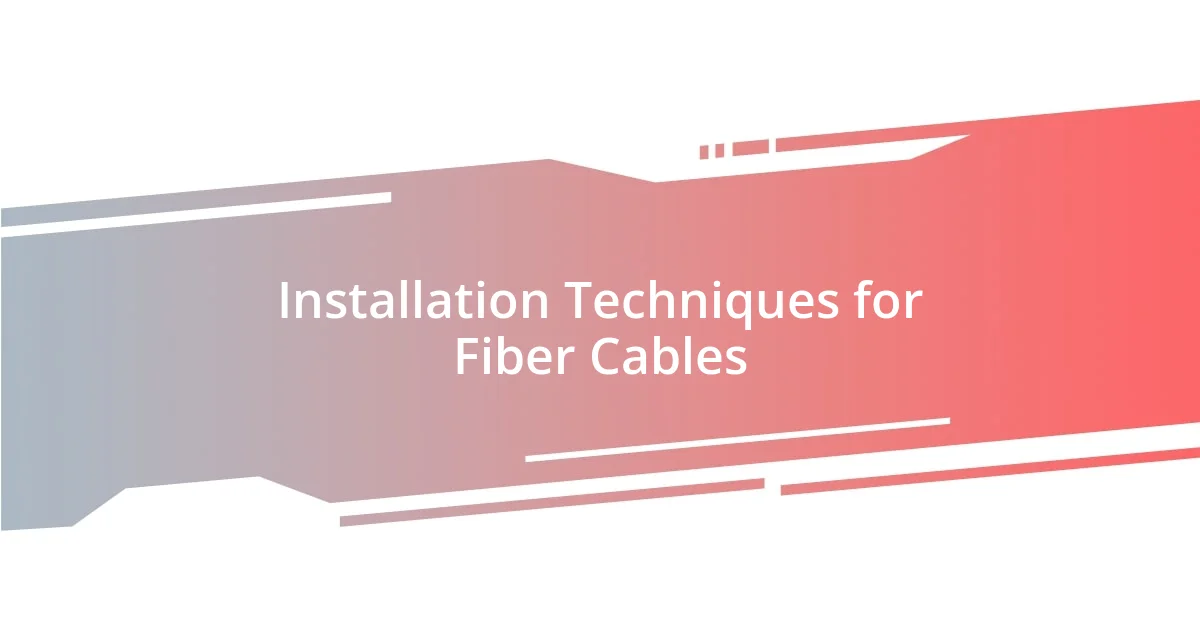
Installation Techniques for Fiber Cables
When it comes to installing fiber cables, the techniques can vary quite a bit based on the environment. I vividly remember my first installation project in a bustling office complex. We used an approach known as “plenum-rated installation,” which involves running cables through air circulation spaces. This is essential for safety. After all, no one wants to compromise on fire safety for the sake of connectivity! Placing the cables properly ensures not only optimal performance but also compliance with building codes.
One key aspect I learned is the importance of proper cable handling during installation. I once witnessed a colleague carefully pulling a new fiber cable through a conduit, but he neglected to watch the bend radius specified for the cable type. This became a learning moment. Overly bending a fiber cable can cause signal loss or even damage the fibers. I always make it a point to check the installation guidelines; they can save you from costly mistakes.
Additionally, I’ve often found that effective communication with your team during installation can make all the difference. For example, on another project, we divided tasks based on individual strengths and experience levels. This collaboration not only sped up the installation but also created a sense of pride as each team member contributed their piece to the puzzle. How important do you think teamwork is in such technical installations? In my experience, it’s absolutely vital—every voice matters when it comes to executing a flawless fiber network setup.
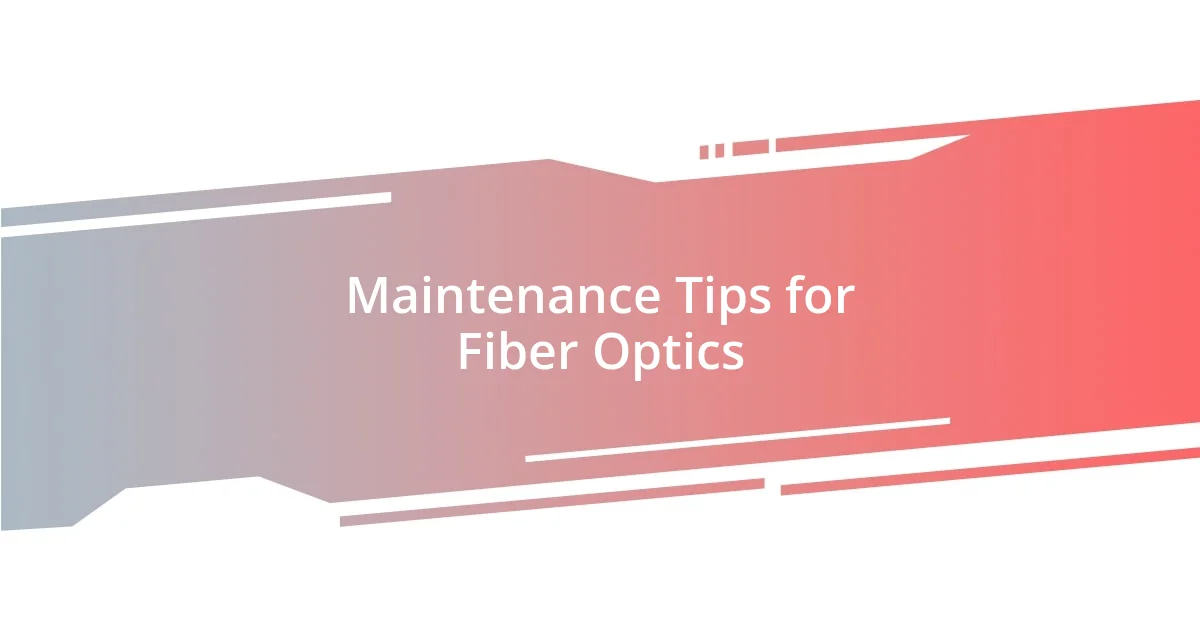
Maintenance Tips for Fiber Optics
When it comes to maintaining fiber optics, regular inspections are crucial. I remember a project where we routinely checked junction boxes and splice points for any signs of wear or dirt. It’s surprising how a little dust can degrade performance, so I always urge my colleagues to prioritize cleanliness in these areas.
Handling fiber optic cables with care is another essential tip I’ve learned. There was a time when I was part of a troubleshooting team, and we found that someone had inadvertently kinked a cable during installation. That minor oversight resulted in significant signal loss, which could have been avoided with a simple reminder to always respect the bend radius. Keeping those cables happy can save a ton of frustration down the road.
Lastly, keeping an eye on temperature and humidity levels can make a big difference in the longevity of fiber optics. I once worked in a facility where extreme temperature fluctuations were common, and we had to invest in more robust enclosures for our fiber cables. Have you considered how environmental factors might silently impact your network? It’s a lesson that has stayed with me, emphasizing that proactive measures can prevent unexpected downtime.
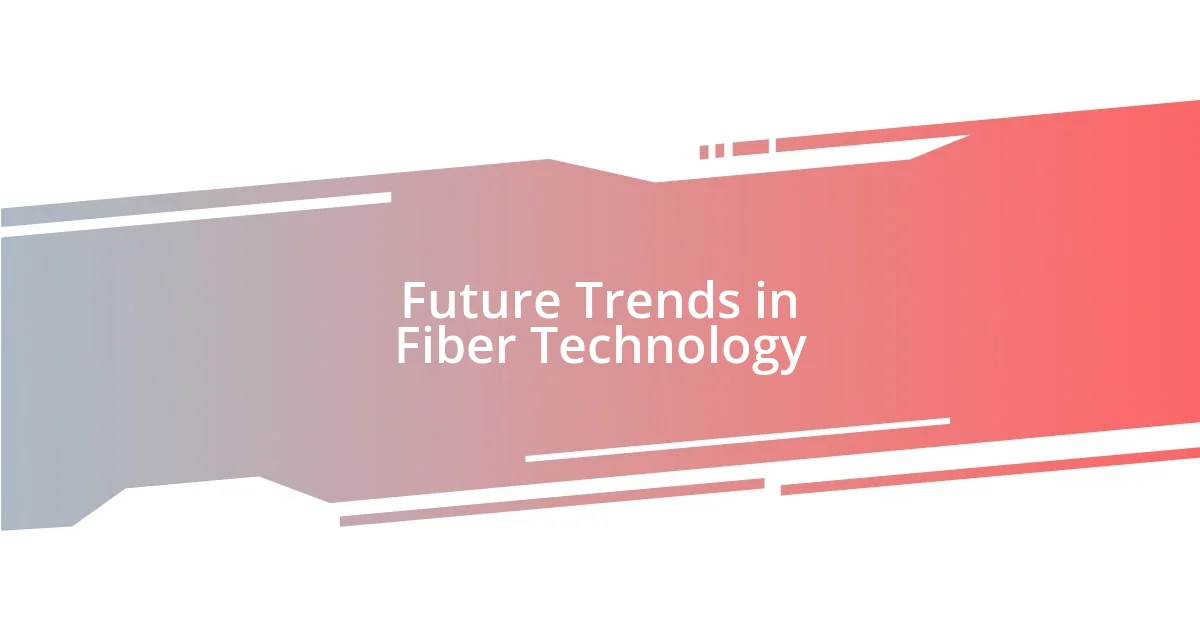
Future Trends in Fiber Technology
One future trend in fiber technology that truly excites me is the development of hollow-core fiber optics. I remember attending a seminar where a researcher passionately described this innovation—essentially, these fibers use air instead of glass to transmit light. Not only could this drastically reduce latency, but it also opens up possibilities for faster internet speeds and greater efficiency. Can you imagine the impact of such advancements on everyday activities like streaming or video conferencing? It’s a game-changer.
Another trend gaining momentum is the integration of artificial intelligence (AI) in fiber network management. I recently had a discussion with a network engineer who shared how they implemented AI-driven monitoring tools in a project. The result? They achieved a significant reduction in downtime and faster troubleshooting. It’s fascinating to see how AI can analyze data patterns in real-time, allowing us to anticipate issues before they escalate. Could AI truly redefine how we approach network reliability? From my perspective, the answer is a resounding yes.
Lastly, we’re seeing a push towards sustainable fiber technologies. During my work at an environmental tech firm, I learned about biocompatible materials being explored for fiber optics production. This means that future cables could minimize waste and environmental impact while still delivering high performance. Isn’t it refreshing to consider that our technology can align with eco-friendly practices? I firmly believe that as we innovate, we should also prioritize our planet’s health, creating a harmonious balance between connectivity and sustainability.










